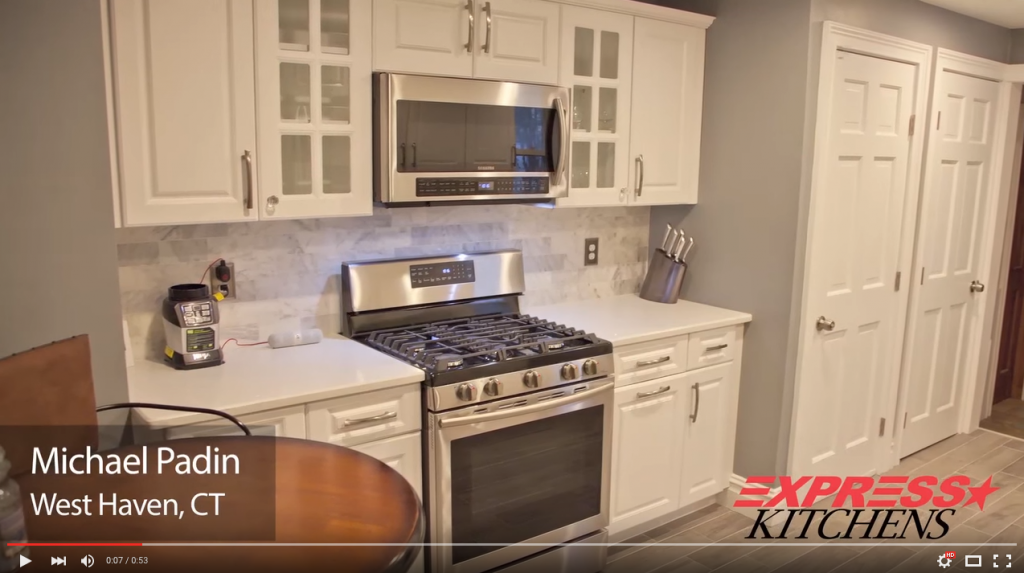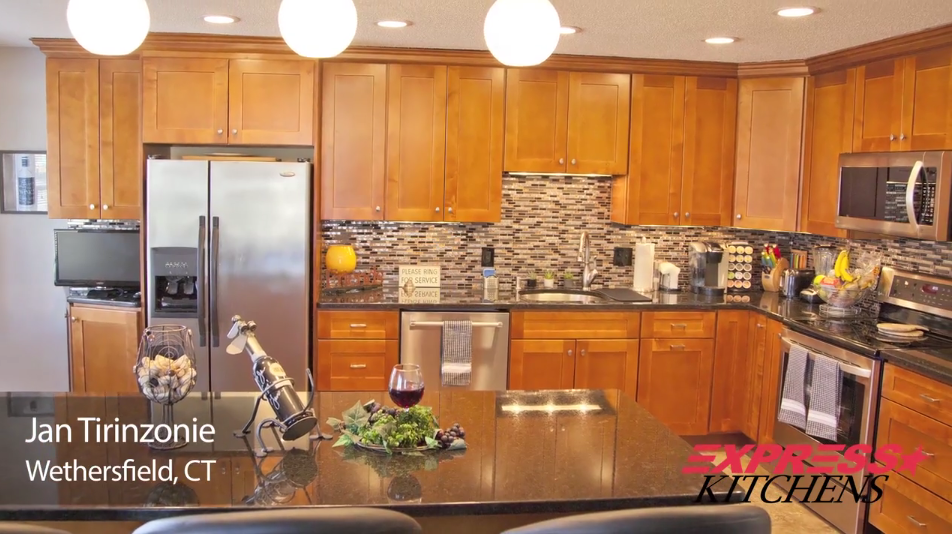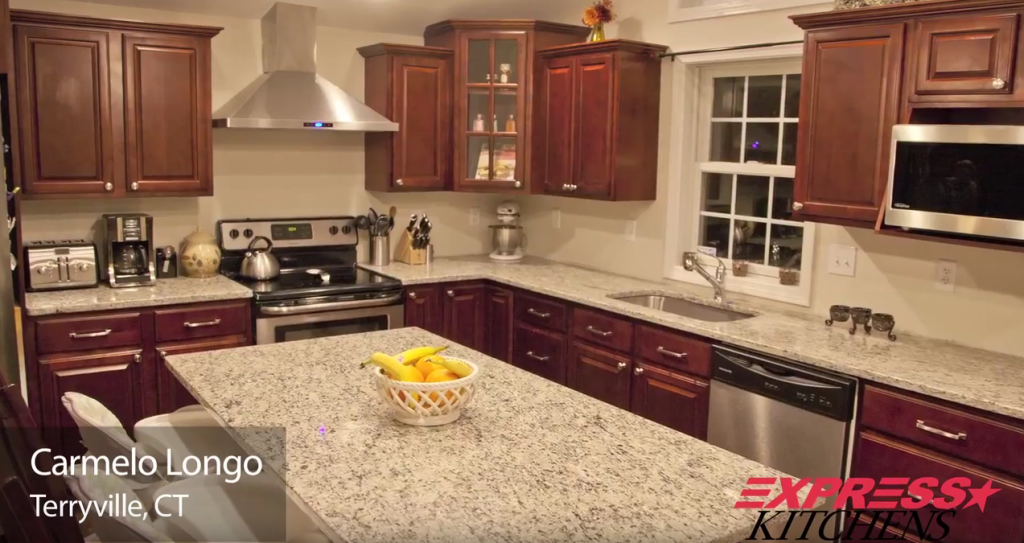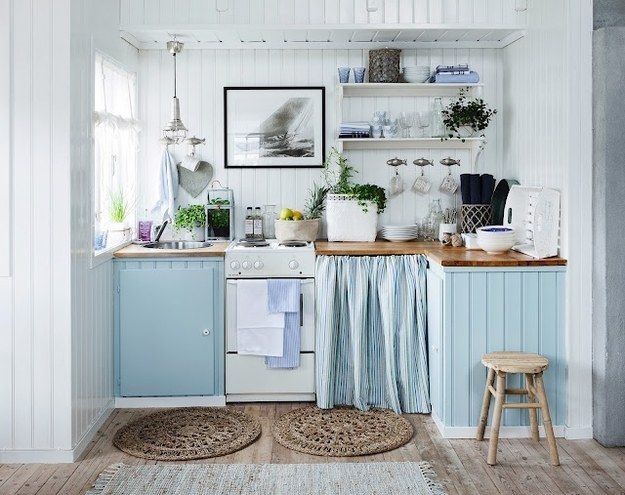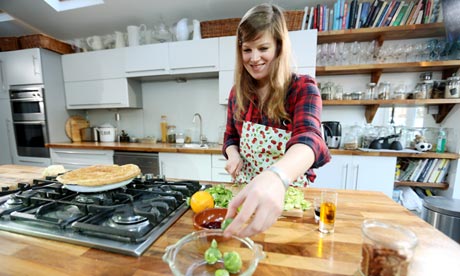Category Archives: Uncategorized
Jan Tirinzonie from Wethersfield, CT shares her Express Kitchens experience!
Carmelo Longo from Terryville, CT shares his Express Kitchens experience!
6 Design Tips To Make Tiny Kitchens Look Larger
9 Kitchen Trends To Watch For In 2016
If you’re anticipating next year’s hottest kitchen trends, we’re right there with you. So what might the quintessential 2016 kitchen look like? We asked two interior designers for a sneak peek at what’s to come. Hi-tech workstations, ’80s glam and muted color schemes are just a few of the looks they say will lead the pack. Without further ado, here are nine trends they predict will define kitchen design in the new year.
1. Soft, muted color palettes. Good news if you’re already thinking about switching up your color scheme: Kitchen colors are changing, according to interior designer Jane Lockhart. Though white motifs will still dominate, everything from cabinets to backsplashes will be done in less saturated tones. “Charcoal, grays and even neutral pastels like pale blue, pale green gray and tinted whites are the new alternative to the standard white,” she says. She also foresees kitchens sporting lighter wood tones, including walnuts, whitewashed woods and white oak in rift grain.
Bold primary colors, on the other hand, will be placed on the back burner. Interior designer Gail Drury says they’re definitely out as accent colors. “Drier colors will become popular,” she says. “Muted blues and greens and pale yellow pastel will be used as accent colors.”
2. Smart spaces. Get ready for a hi-tech makeover. Both Lockhart and Drury predict more kitchens will have designated spots for smart devices next year. “Look for areas with hidden charging stations to store devices like phones and tablets so that they are always operable, at hand and charged,” Lockhart says.
Drury says the quintessential 2016 kitchen will focus on convenience for families on the go via accessible smart appliances. “I expect kitchens full of state-of-the-art appliances, from steam ovens to built-in coffee machines to wine coolers.”
3. An ’80s reboot. “The ’80s are back,” Lockhart says. Mirrored backsplashes, brass accessories and high-gloss surfaces aren’t dead by a long shot, but they’re more elegant and refined this time around. “An elegance not seen in the ’80s will be an incorporation of a variety of natural materials to remove the ‘plastic’ look of that great hair decade,” Lockhart says. Drury adds that homeowners will opt for brass with satin rather than shiny finishes.
4. Metal range hoods. One of last year’s biggest trends was metallic finishes, be it copper, brass or bronze. However, homeowners went with small helpings of metal, primarily using faucets, pendant lights and cabinet pulls to incorporate this raw texture.
In 2016, metal will assume a more dominant role in kitchen aesthetics and trump wood as the range hood of choice. “Wood mantle hoods are being replaced with metal hoods or ones that are a combination of wood and metal,” Drury says. If you’re planning to follow suit with next year’s fixation on neutral color tones, a metal hood can introduce a burst of contrast into your kitchen.
5. Integrated kitchen-living spaces. Maybe your kitchen feels disconnected from the rest of your home. Maybe you want your cooking space to feel more accommodating. Either way, this trend could be for you. Lockhart anticipates more streamlined kitchen designs in which the kitchen converges with the home’s primary living space. “It will become part of the main living space even further,” she says. Designers will merge kitchens and living rooms by including hidden and integrated appliances.
6. A new kind of tradition. While it’s no surprise that present-day kitchens are embracing simple design, Lockhart expects traditional spaces to hop on board too. “Even traditional kitchens may experience a slightly cleaner feel with bold lines and less fussy details,” she says.
But Lockhart says it isn’t the end of traditional design as we know it. It just means homeowners will opt for fewer frills and more calculated, strategically placed details. “Traditional designs will always remain popular, but future renditions will be more deliberate with an emphasis on key elements like hoods, islands, cabinet crowns and so on,” she says.
7. Texture-on-texture contrast. It’s time to reimagine contrast in 2016. Drury says variations in texture will rule, rather than traditional methods of contrast. “Strong contrasting designs are being replaced with more texture-on-texture designs,” she says.
It won’t be about mixing and matching textures, though. Instead, designers will reposition the same texture in different patterns throughout the kitchen. “The same exact stone can be finished three ways and combined in the same space,” Drury says. “The difference is very subtle but at the same time makes a statement about attention to detail.”
8. A nod to midcentury mod. Lockhart credits this trend to the popularity of midcentury modern furniture and says the period design will trickle down to kitchens. “To some extent, this is already occurring with the increasing use of walnut in islands and cabinet doors,” she says. “But look for more kitchen styles that offer a nod to ’60s modern style, also called Nordic style.” You can get in on this minimalist movement by choosing predominantly white color palettes, designing with light wood textures and clearing away unnecessary clutter. Nordic design is all about simplicity and functionality.
9. Well-lit cabinetry. Homeowners won’t settle for just ceiling lights and table lamps to illuminate their kitchens. The two designers say extensive cabinet lighting is a trend to watch. “Low-voltage light tape strips are used as accent pieces below cabinets, above cabinets, inside cabinets and below countertop overhangs,” Drury says. “LED lights are the norm.” These features will be grouped with recessed can lights to offer better mood-setting capabilities.
9 rules to guide cooks in the kitchen
No one is really “born” a cook or a baker or a candymaker. Not even the world’s culinary stars.
The road to becoming comfortable in the kitchen, a cook will tell you, is rarely straight or smooth. It is riddled with scorched pans, oversalted soups, scars, underseasoned stews, burns and flops.
So promise yourself, perhaps as a belated New Year’s resolution, to get into the kitchen and cook or bake or make candy or pickles or … you get the idea. Maybe it will be a solo creative pursuit, and the steady chop of a knife against a cutting board will become a focused meditation. Or maybe it will be a weekend shared-cooking feast with friends. Or a family affair with children helping prepare a meal.
No matter what, let the power of cooking work its magic. Flops and all.
And when flops happen, quote Ray Bradbury: “Life is trying things to see if they work.” With a little help from some friends, of course:
Fix the flops: “Anyone who does a lot of cooking has flops, and each one teaches you something. … If you’ve had a great flop, take a ‘what-the-hell’ attitude, and pull the dish through with flair,” the late Julia Child told us 30-plus years ago. Recalling a deflated chocolate souffle she decorated with whipped cream, dubbed “chocolate torte” and served to guests, she added, “Keep in mind that your audience doesn’t know what you’re aiming for, so don’t let on.”
Know where you went wrong: Chef Jacquy Pfeiffer, co-founder of the French Pastry School in Chicago, tells students, “It’s very possible that a recipe will not work out right away. Sometimes very simple things, like you don’t let your ingredients come to room temperature, might make the recipe fail. … It’s more important to know how a screwed-up recipe looks, and it’s even more crucial to know how to fix it, than to make the perfect pastry.”
Don’t overdepend on gadgets: “My favorite kitchen tool is my hands,” said Connecticut cookbook author Pam Anderson. “When you go in the kitchen, wash your hands and touch, smell, taste, look – freely. … There’s nothing like pulling pizza dough or bread dough out of the food processor, pouring it onto the countertop and giving it that final 30 seconds to a minute kneading to pull it into that baby’s-butt smooth texture.”
Learn how foods feel: “You can’t just follow a recipe and have it turn out,” said Paula Haney of Hoosier Mama Pie Co. in Chicago. “The recipe for a pie crust is going to be variable depending on the weather and humidity, so you kind of have to have a feel for it. … You only have flour, butter and cold water. So I think it takes on this sort of magical thing.”
Plan but be flexible: When chef Stephanie Izard (Girl & the Goat, Little Goat) plans a multicourse meal, “You want to have a little acidity; you want a little sweetness, a little spice or a little salty,” she told us. “With each dish, I’m always trying to make the whole mouth happy.” How do you start? “Pick the proteins first, (then) be flexible because you definitely want to base it on what’s looking good at the market.”
Don’t overdo it: “People try to do too much,” said legendary chef and cookbook author Jacques Pepin. “They take a cooking class, learn seven desserts and try to do all of them. It’s better to do one well.”
Simplify: “Almost everybody who is cooking dinner on a weeknight is doing a (‘Top Chef’) Quickfire Challenge,” said chef and cookbook author Rick Bayless (Frontera Grill, Topolobampo, Xoco, etc. “You don’t have very much time. You just have to get dinner on the table, but you want it to be delicious.” Understand how a recipe works, then “go into the kitchen and make something that’s just exactly right for you.” Improvise, he said, balancing flavors and textures.
Memorize these secret ingredients: Lauren Braun Costello, in “Notes on Cooking: A Short Guide to an Essential Craft,” explained that sweetness (a touch of sugar, agave syrup or balsamic vinegar) can boost a dull tomato sauce. Vinegars and lemon can “add brightness” to nearly everything. And a pinch of salt? “It makes everything brighter and stronger, (but) that doesn’t mean that things should taste salty,” she said. Foods such as Parmesan, capers and anchovies can add saltiness to dishes.
Rethink recipes: When chef Art Smith had to lose weight for health reasons, he worked on his favorite recipes. “Roasting is probably the healthiest way to cook,” he said. “I don’t think anything blanched or boiled has any flavor. Roasting intensifies the color and the flavor of food.”
Faruk & Zakira Bhura share their Express Kitchens experience!
The Ettorre family share their Express Kitchens experience!
10 Ways to Reset Your Kitchen for the New Year!
1. Scour your pots and pans.
Yes, I’m actually telling you to scrub your dishes when you haven’t cooked anything in them — and we’re talking the kind of work that requires elbow grease. Even when well-washed with dish soap, frequently used stainless pots and pans get patches — especially along the sides, edges, and exteriors, where cooked on fats tend to stubbornly cling.
Steel wool can scratch, so instead pick up a non-abrasive sponge and a mildly abrasive product or baking soda, and get in there for a thorough scrub.
2. Clean or change your stove vent fan filter.
Whether you have a fancy range hood or the classic apartment vent fan that blows exhaust directly into your face, it could use a fresh start. The good news is that a fresh start requires little more than a kettle of hot water, a dish brush, and some soap. If you don’t remember the last time the filter was changed, it’s probably worth picking up a new one at your local hardware store or online. Check your owner’s manual. If you’re in a rental and there’s no manual to be found, look up into the range hood; there’s likely a sticker to tell you the serial number of the filter you’ll need.
3. Clean your oven.
Whether sputtering grease from a Christmas goose, overflowing pie filling, or bubbling green bean casserole, there is likely something spilled onto the floor of your oven right now. You can, if your oven has this option, run the oven cleaning cycle or use a combination method that pairs a solvent and some scrubbing. Pick up some all-natural grill and oven cleaner, baking soda and vinegar, or — in really tough cases — ammonia.
4. Treat your wooden tools.
Think of this as massage time for some of your most beautiful and beloved kitchen workhorses: your wooden spoons, cutting boards, and wooden-handled knives. Wash them by hand and towel dry them thoroughly; then apply mineral oil or, in dire cases, equal parts mineral oil and food-grade beeswax, melted together and allowed to cool until thickened. Rub either into the edges of your boards and tools and allow them to sit overnight. Buff any excess oil or balm away with a fresh towel the next day and your tools will be glossy, smooth, and ready for anything.
5. Deal with your drawers & edit your tool collection.
The drawers closest to the kitchen counter tend to catch crumbs, and pulling everything out to clean them is a great chance to assess your kitchen tools. Before you return things to the drawer, be honest with yourself about the last time you used them.
Chances are that the pastry blender, julienne peeler, candy thermometer, and cherry pitter probably don’t need to be in your most easily accessible storage space. There’s nothing wrong with storing these occasionally used tools elsewhere — even out of the kitchen. Garlic press you never use? Duplicates of anything? Donate them. Your drawers will be less cluttered and your tools will be more of a pleasure to use.
6. Change your water filter.
The first week of the year is a great one for updating things that need to be done periodically, like replacing the filter in your water pitcher, and giving the pitcher itself a thorough wash. Recycle the old filter, get a new one going, and set a reminder on your calendar to do it again in three months.
7. Clean or replace dishwashing tools.
Freshen your scrub brush with a trip through the dishwasher, or soak the bristle end in distilled white vinegar for an hour or two and then hang to dry. While you’re at it, boil your dish rags and then wash and dry them as usual. If you’re still on team sponge, this is not the time to microwave. Get a fresh one and resolve to squeeze it dry after each use. No matter what kind of dishwashing tools you use, assess them honestly and replace them if it’s time. Having a clean slate is a great incentive to keep things nice beyond January.
8. Clean your dishwasher.
If you’ve got a dishwasher in your life, it likely saved you from hand-washing countless plates after parties this holiday season. If so, you owe it some spa time. Deep cleaning your dishwasher isn’t even an arduous task: Clean the filter, give forgotten spots a good wipe-down, and run a cycle with some vinegar.
9. Clean your garbage disposal & microwave.
What’s the best way to clean your microwave? With a lemon, some water, and a dishtowel. What’s the best way to clean your garbage disposal? With a lemon, a few ice cubes, and a handful of salt. Get the most out of that lemon by completing these two tasks in succession for a kitchen reset you can cross off the list on a weeknight.
10. Deep clean your refrigerator & freezer.
Perhaps not the project to take on after a long day — this is a tedious one with a big payoff. It’s time to tackle your refrigerator: Pull everything out of it, stowing any truly temperature-sensitive items like meat or dairy into a cooler. Throw away or compost tired leftovers; condiments; and forgotten half-empty jars of jam, pickles, or anything else you won’t actually eat. Be ruthless. Then follow our guide to truly clean your refrigerator. Repeat this process with your freezer. Treat yourself to fresh boxes of baking soda to keep in the doors of each to absorb aromas.
